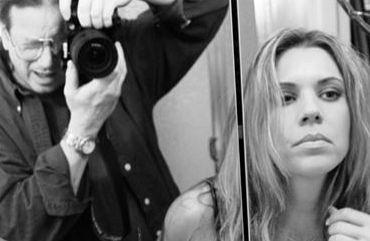The digital photography age is an era of instant gratification as far as picture making is concerned. When Kodak introduced the Brownie in 1900 it advertised, “You push the button – we do the rest.” In a time of heavy view cameras, tripods and glass plates, it was a technological marvel to be able to shoot snapshots with a small, portable camera, send in the film and get prints back a short time later.
[caption id="attachment_3716" align="aligncenter" width="640"]
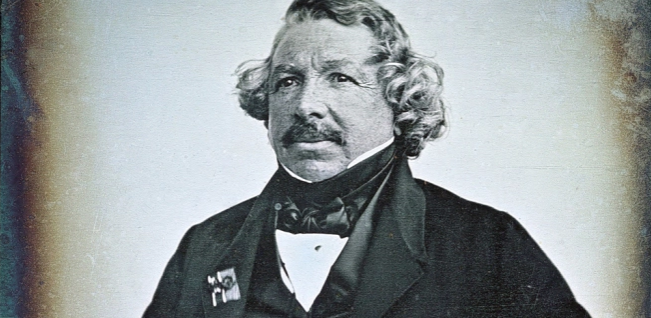
Lous Daguerre – inventor of the Daguerreotype |
Source: http://bit.ly/2ddSjSR[/caption]
But nobody 100 years ago had any idea a photographic system would evolve where pixels would be captured electronically on a card, you could see a representation of the image instantly on the back of the camera and aspects of the photo like exposure, white balance, contrast, cropping and sharpness could be adjusted using software on a computer.
A computer? Back then the term referred to somebody who did computations.
[caption id="attachment_3717" align="aligncenter" width="631"]
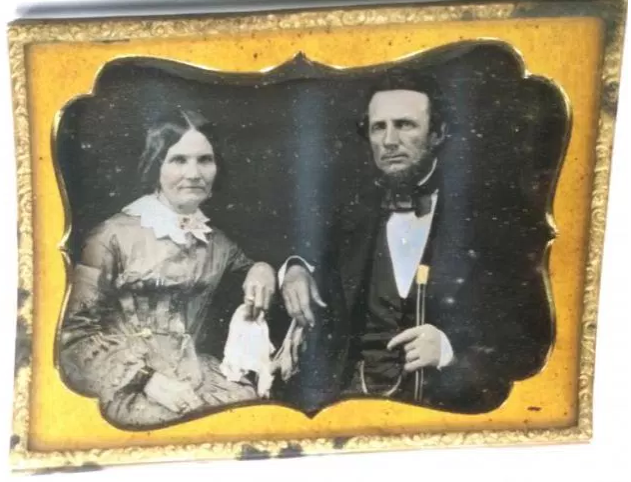
Daguerreotype captioned as image of Abraham and Mary Todd Lincoln |
Source: http://bit.ly/2iKlFxT[/caption]
[caption id="attachment_3718" align="aligncenter" width="514"]
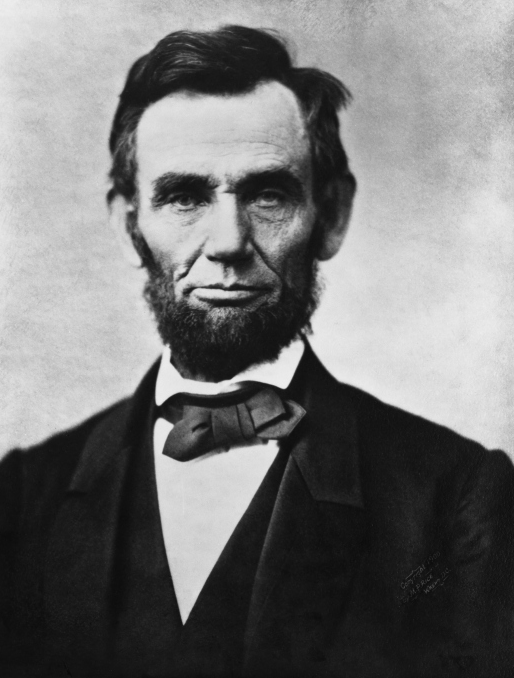
The negative and print process largely replaced Daguerreotypes by the time of the Civil War. Another view of Abraham Lincoln |
Credit: Lous Daguerre[/caption]
The first practical system of photography was invented by Louis Daguerre in 1839. How did this system work? According to Wikipedia…
To make a daguerreotype, the daguerreotypist would polish a sheet of silver-plated copper to a mirror finish, treat it with fumes that made its surface light sensitive, expose it in a camera for as long as was judged to be necessary, which could be as little as a few seconds for brightly sunlit subjects or much longer with less intense lighting; make the resulting latent image on it visible by fuming it with mercury vapor; remove its sensitivity to light by liquid chemical treatment, rinse and dry it, then seal the easily marred result behind glass in a protective enclosure.
Each daguerreotype was delicate and unique, a one-off example like a painting so you couldn’t make multiple prints of different sizes. This process was popular in the 1840s and 1850s but was soon superseded by a negative and print technology invented by William Henry Fox Talbot, based on processes that had been slowly evolving for decades and which remained the basis of almost all photography until the introduction of electronic imaging.
[caption id="attachment_3719" align="aligncenter" width="640"]
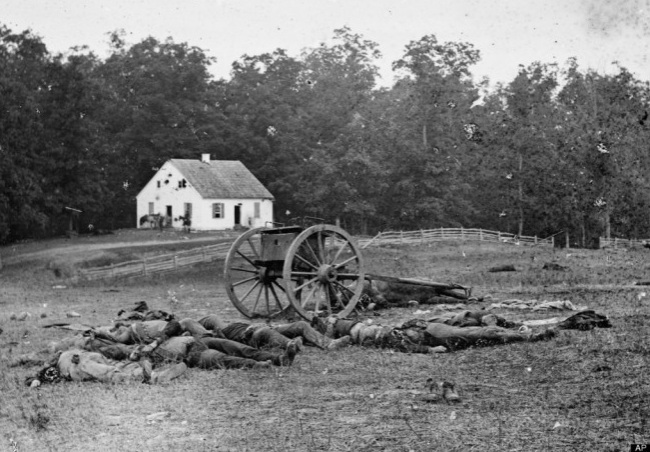
Before photography, the public had never seen graphic images of an actual battlefield. Real war, real dead bodies.
Photo: Mathew Brady[/caption]
[caption id="attachment_3720" align="aligncenter" width="640"]
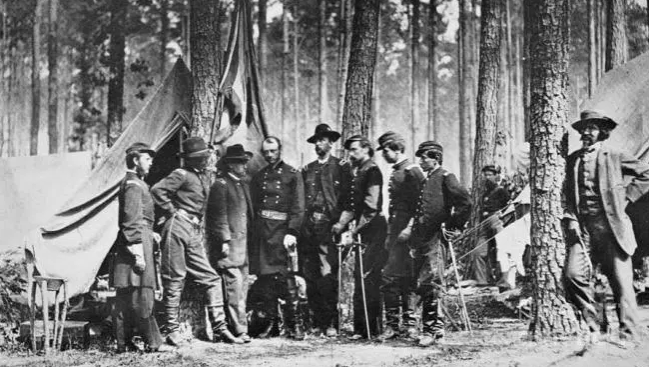
Civil War soldiers by
Mathew Brady.[/caption]
[caption id="attachment_3721" align="aligncenter" width="623"]
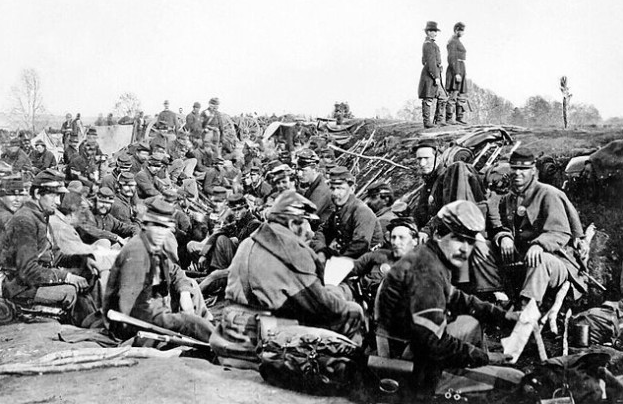
Civil War reenactments don’t really give the sense of how miserable an experience it could be serving during the conflict. About 620,00 died during the war and there were millions of casualties.
Photo: Mathew Brady.[/caption]
Photography at that point was done by coating a glass plate with a photo-sensitive emulsion and quickly exposing it before it dried. Large view cameras were used, the plates were inserted in holders and held in place by spring-loaded backs. Lenses and emulations were slow so in very early photos of cities there are no people visible – or you see them only as vague blurs. Shooting this way was good for architectural photography and landscapes, where the subject never moves.
The impact of photography on the culture was extreme. Remember, prior to this there was no way to record an image that could be viewed by others at other times in different places. Previously the only way to do this was by painting or drawing or images created in stained glass. People could now see what Paris, Rome or the Taj Mahal were like without traveling there. They were able to know what the famous like Abraham Lincoln really looked like. They could have their portraits done and photos of their entire families. A young man in love could have a picture of his lady to look at when they were separated.
[caption id="attachment_3744" align="aligncenter" width="497"]
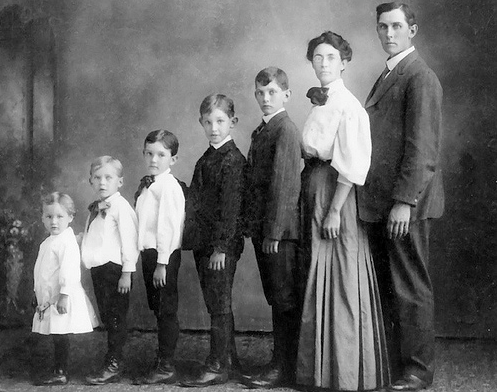
The family portrait was a bread and butter job for 19th-century photographers. Until Kodak introduced the Brownie, this was the only way to get an image of your family.
Source: http://bit.ly/2ivuqc6[/caption]
Nowadays we are accustomed to seeing all aspects of the world, every place and every situation. War images from Afghanistan? Gruesome at times but not unfamiliar. But think of the impact of Mathew Brady’s photos of the Civil War – fields strewn with dead bodies, casualties missing arms and legs, dirty and bedraggled war-weary soldiers at the brink of exhaustion. In the past, the public had seen artistic depictions of war but never before had access to the stark reality of actual battlefields.
Photographic technology continued to develop and wet plates gave way to dry emulsions that didn’t have to be developed very soon after exposure. So a photographer on location could travel with a lot of plates, expose and then process them later, with no need to have a darkroom right to hand. This was still a cumbersome process. But no longer any need to use horse-drawn wagons filled with cameras, photographic plates, and portable processing facilities. This meant photographers could travel to more places to create images and the public was soon treated to more and more exciting photographs of far away places and exotic cultures.
[caption id="attachment_3725" align="aligncenter" width="640"]
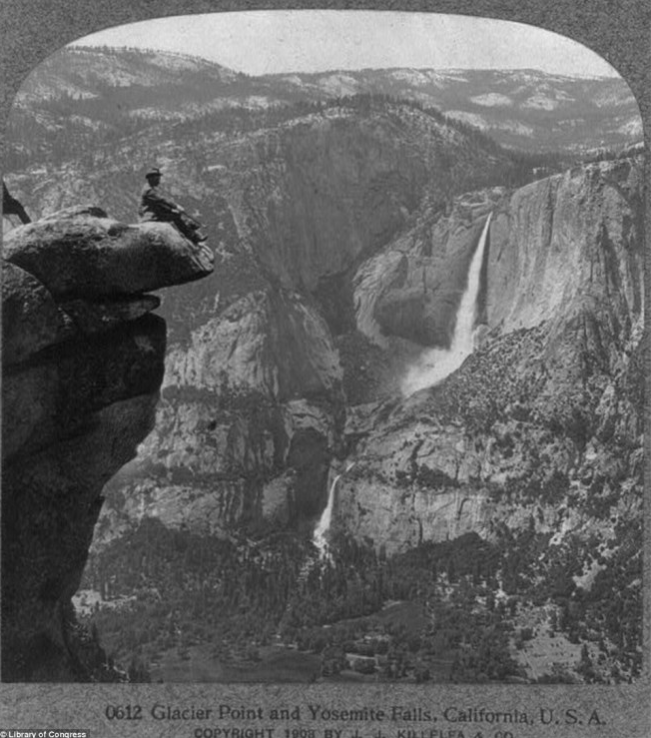
Glacier Point and Yosemite Falls – Photographs of great western landscapes helped establish the National Parks System. Ansel Adams wasn’t the first to photograph these awesome views.
Credit: Library of Congress\ J.J. Killelea[/caption]
[caption id="attachment_3726" align="aligncenter" width="640"]
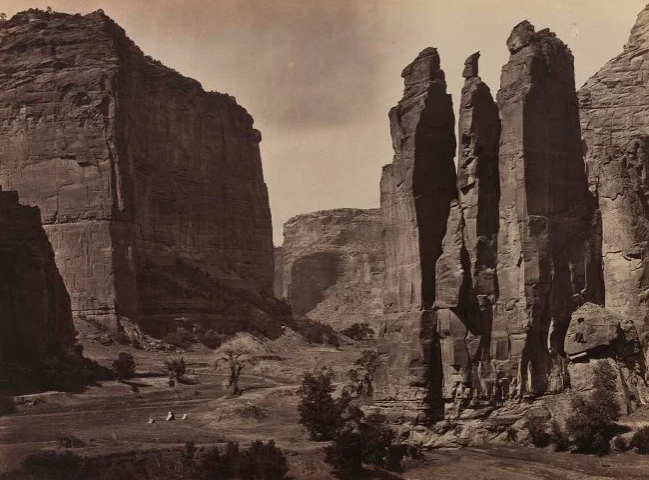
The Grand Canyon, 1873 –
photographer Timothy O’Sullivan.[/caption]
[caption id="attachment_3727" align="aligncenter" width="640"]
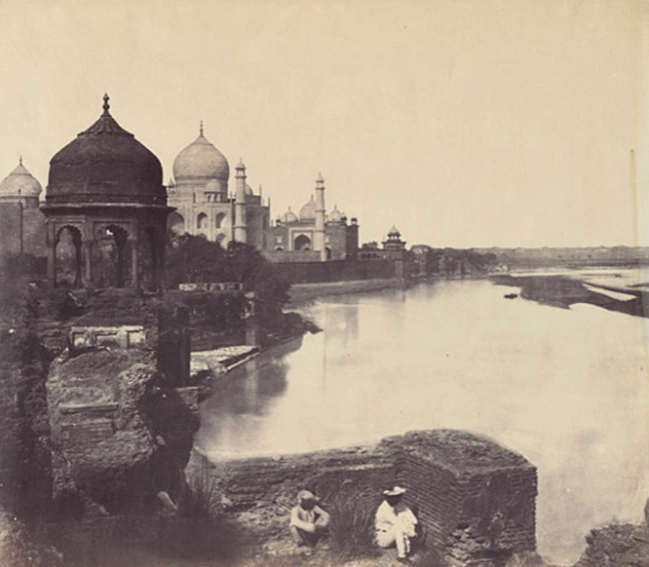
Before photography, most people could only see drawings or paintings of the Taj Mahal, not an image representing the real thing. Photography could bring you the world.
Credit: Dr. John Murray[/caption]
The 19th century was a period where people first began to appreciate the incredible landscapes to be found in America, especially the West and when the first National Parks were designated. Landscape photos of places like Yellowstone, Yosemite and the Grand Canyon were so amazing that at first many didn’t believe these were real locations. The public was impressed and inspired by these photos and so was Congress, which began to expand the list of National Parks. Yellowstone was the first, signed into law by President Ulysses S. Grant in 1972. Currently, there are 59 protected areas supervised by the National Park Service.
[caption id="attachment_3728" align="aligncenter" width="640"]
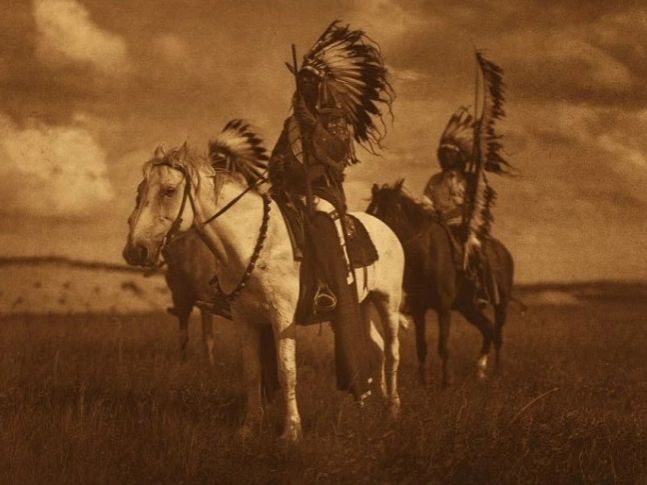
Edward Curtin created some of the most iconic photos of Native Americans ever. Not Hollywood stereotypes, but the real thing.
Credit: Edward Curtin [/caption]
[caption id="attachment_3729" align="aligncenter" width="585"]
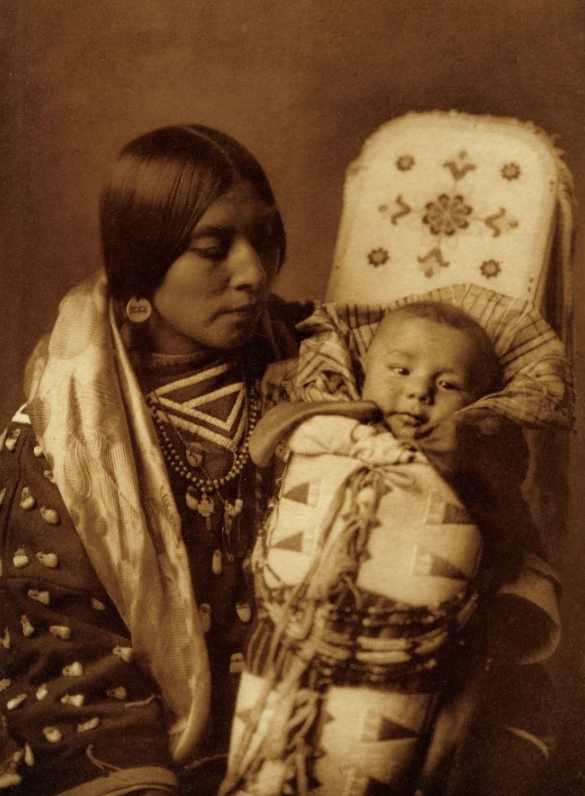 Photo by Edward Curtis
Photo by Edward Curtis[/caption]
[caption id="attachment_3730" align="aligncenter" width="324"]
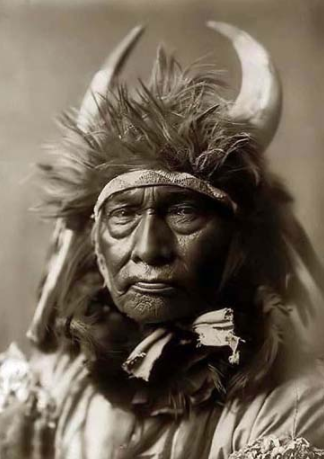
A long way from the Hollywood view of the American Indian. Photo of Sitting Bull
by Edward Curtis.[/caption]
Photography also introduced people to different populations and exotic cultures. For example, Edward S. Curtis was an ethnologist who began photographing American Indians in the late 1990s, eventually with the support of the National Photographic Society. He also used photography to document a tribe of headhunters. In a world in which TV and the movies have given us highly fictionalized images of Native Americans you can look at the photos Curtis did of the real thing to see what they really looked like.
Documentary photography has had a major impact on how the American culture viewed itself. The Civil War photos gave them a clearer idea of the costs of combat. Photos of slums created the same kind of insights as to the plight of the poor and of children that were described in the novels of Charles Dickens. Over time pictures of child labor, tenement living, industrial conditions, pollution and farmland destroyed by drought and dust lead to changes in US law and labor regulations.
[caption id="attachment_3732" align="aligncenter" width="589"]
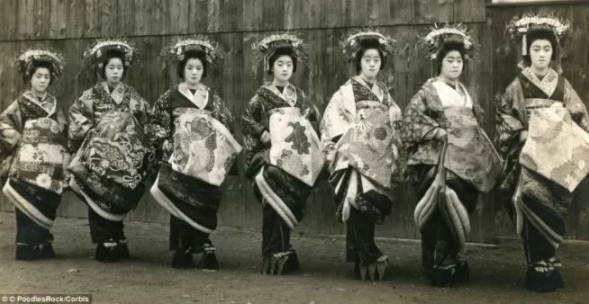
Another kind of fashion: Japanese Geishas in the 1800s. Photography gave access to distant peoples and cultures.
Credit: Corbis[/caption]
Photography also had a major influence on fashion. Previously, drawings and illustrations had been used to document changes in dress and fashion but now there was a way to show the actual garments, dresses, hats, shoes and so forth. The spread of these images increased as magazines and newspapers found ways of printing photos and sharing them with the public.
[caption id="attachment_3734" align="aligncenter" width="405"]
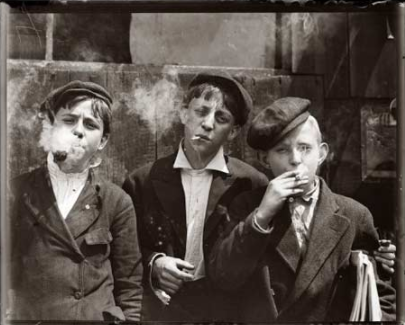
Lewis Hine used photography to help change child labor laws in the United States.
Credit: Lewis Hine[/caption]
As the 19th turned into the 20th century, photography became more widespread and mainstream. Everyone was taking snapshots and published photos were everywhere. The invention of motion pictures provided another way of sharing images of all aspects of reality with the public. Photography went from being an almost wondrous invention yielding magical experiences to very much an ordinary and normal fact of daily life.
[caption id="attachment_3736" align="aligncenter" width="588"]
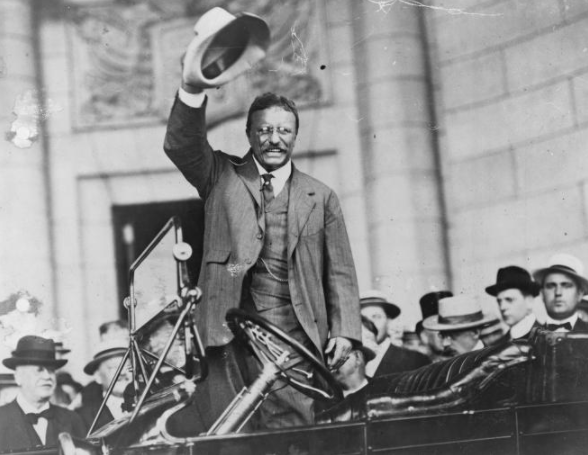
Teddy Roosevelt was one of the first politicians to capitalize on photography to promote his image and increase his celebrity.
Credit: AP Photo[/caption]
But it is worth stopping to recall what an amazing experience looking at a photograph was in the very early days of photography. There was a reason that in some cultures refused to be photographed for fear the camera was capturing their souls. For all of history no process existed that could capture and fix and realistic looking image – and suddenly there was.
So no wonder people were so amazed back when photography was new.
Bill Dobbins is a pro photographer located in the Westwood area of Los Angeles. He is a veteran photographer and videographer who has published eight books, including two fine art photo books:
WEBSITES
[caption id="attachment_3739" align="aligncenter" width="587"]
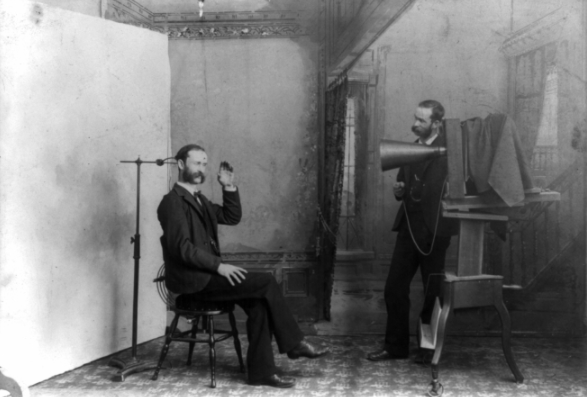
Portrait photographer in 1893 was a slow process. Lenses were slow and so were emulsions. Exposures could take a long time and clamps were used to hold the head steady. Not much personality possible in this kind of portrait.
Source: http://bit.ly/2iKragn[/caption]
 Lous Daguerre – inventor of the Daguerreotype | Source: http://bit.ly/2ddSjSR[/caption]
But nobody 100 years ago had any idea a photographic system would evolve where pixels would be captured electronically on a card, you could see a representation of the image instantly on the back of the camera and aspects of the photo like exposure, white balance, contrast, cropping and sharpness could be adjusted using software on a computer.
A computer? Back then the term referred to somebody who did computations.
[caption id="attachment_3717" align="aligncenter" width="631"]
Lous Daguerre – inventor of the Daguerreotype | Source: http://bit.ly/2ddSjSR[/caption]
But nobody 100 years ago had any idea a photographic system would evolve where pixels would be captured electronically on a card, you could see a representation of the image instantly on the back of the camera and aspects of the photo like exposure, white balance, contrast, cropping and sharpness could be adjusted using software on a computer.
A computer? Back then the term referred to somebody who did computations.
[caption id="attachment_3717" align="aligncenter" width="631"] Daguerreotype captioned as image of Abraham and Mary Todd Lincoln | Source: http://bit.ly/2iKlFxT[/caption]
[caption id="attachment_3718" align="aligncenter" width="514"]
Daguerreotype captioned as image of Abraham and Mary Todd Lincoln | Source: http://bit.ly/2iKlFxT[/caption]
[caption id="attachment_3718" align="aligncenter" width="514"] The negative and print process largely replaced Daguerreotypes by the time of the Civil War. Another view of Abraham Lincoln | Credit: Lous Daguerre[/caption]
The first practical system of photography was invented by Louis Daguerre in 1839. How did this system work? According to Wikipedia…
To make a daguerreotype, the daguerreotypist would polish a sheet of silver-plated copper to a mirror finish, treat it with fumes that made its surface light sensitive, expose it in a camera for as long as was judged to be necessary, which could be as little as a few seconds for brightly sunlit subjects or much longer with less intense lighting; make the resulting latent image on it visible by fuming it with mercury vapor; remove its sensitivity to light by liquid chemical treatment, rinse and dry it, then seal the easily marred result behind glass in a protective enclosure.
Each daguerreotype was delicate and unique, a one-off example like a painting so you couldn’t make multiple prints of different sizes. This process was popular in the 1840s and 1850s but was soon superseded by a negative and print technology invented by William Henry Fox Talbot, based on processes that had been slowly evolving for decades and which remained the basis of almost all photography until the introduction of electronic imaging.
[caption id="attachment_3719" align="aligncenter" width="640"]
The negative and print process largely replaced Daguerreotypes by the time of the Civil War. Another view of Abraham Lincoln | Credit: Lous Daguerre[/caption]
The first practical system of photography was invented by Louis Daguerre in 1839. How did this system work? According to Wikipedia…
To make a daguerreotype, the daguerreotypist would polish a sheet of silver-plated copper to a mirror finish, treat it with fumes that made its surface light sensitive, expose it in a camera for as long as was judged to be necessary, which could be as little as a few seconds for brightly sunlit subjects or much longer with less intense lighting; make the resulting latent image on it visible by fuming it with mercury vapor; remove its sensitivity to light by liquid chemical treatment, rinse and dry it, then seal the easily marred result behind glass in a protective enclosure.
Each daguerreotype was delicate and unique, a one-off example like a painting so you couldn’t make multiple prints of different sizes. This process was popular in the 1840s and 1850s but was soon superseded by a negative and print technology invented by William Henry Fox Talbot, based on processes that had been slowly evolving for decades and which remained the basis of almost all photography until the introduction of electronic imaging.
[caption id="attachment_3719" align="aligncenter" width="640"] Before photography, the public had never seen graphic images of an actual battlefield. Real war, real dead bodies. Photo: Mathew Brady[/caption]
[caption id="attachment_3720" align="aligncenter" width="640"]
Before photography, the public had never seen graphic images of an actual battlefield. Real war, real dead bodies. Photo: Mathew Brady[/caption]
[caption id="attachment_3720" align="aligncenter" width="640"] Civil War soldiers by Mathew Brady.[/caption]
[caption id="attachment_3721" align="aligncenter" width="623"]
Civil War soldiers by Mathew Brady.[/caption]
[caption id="attachment_3721" align="aligncenter" width="623"] Civil War reenactments don’t really give the sense of how miserable an experience it could be serving during the conflict. About 620,00 died during the war and there were millions of casualties. Photo: Mathew Brady.[/caption]
Photography at that point was done by coating a glass plate with a photo-sensitive emulsion and quickly exposing it before it dried. Large view cameras were used, the plates were inserted in holders and held in place by spring-loaded backs. Lenses and emulations were slow so in very early photos of cities there are no people visible – or you see them only as vague blurs. Shooting this way was good for architectural photography and landscapes, where the subject never moves.
The impact of photography on the culture was extreme. Remember, prior to this there was no way to record an image that could be viewed by others at other times in different places. Previously the only way to do this was by painting or drawing or images created in stained glass. People could now see what Paris, Rome or the Taj Mahal were like without traveling there. They were able to know what the famous like Abraham Lincoln really looked like. They could have their portraits done and photos of their entire families. A young man in love could have a picture of his lady to look at when they were separated.
[caption id="attachment_3744" align="aligncenter" width="497"]
Civil War reenactments don’t really give the sense of how miserable an experience it could be serving during the conflict. About 620,00 died during the war and there were millions of casualties. Photo: Mathew Brady.[/caption]
Photography at that point was done by coating a glass plate with a photo-sensitive emulsion and quickly exposing it before it dried. Large view cameras were used, the plates were inserted in holders and held in place by spring-loaded backs. Lenses and emulations were slow so in very early photos of cities there are no people visible – or you see them only as vague blurs. Shooting this way was good for architectural photography and landscapes, where the subject never moves.
The impact of photography on the culture was extreme. Remember, prior to this there was no way to record an image that could be viewed by others at other times in different places. Previously the only way to do this was by painting or drawing or images created in stained glass. People could now see what Paris, Rome or the Taj Mahal were like without traveling there. They were able to know what the famous like Abraham Lincoln really looked like. They could have their portraits done and photos of their entire families. A young man in love could have a picture of his lady to look at when they were separated.
[caption id="attachment_3744" align="aligncenter" width="497"] The family portrait was a bread and butter job for 19th-century photographers. Until Kodak introduced the Brownie, this was the only way to get an image of your family. Source: http://bit.ly/2ivuqc6[/caption]
Nowadays we are accustomed to seeing all aspects of the world, every place and every situation. War images from Afghanistan? Gruesome at times but not unfamiliar. But think of the impact of Mathew Brady’s photos of the Civil War – fields strewn with dead bodies, casualties missing arms and legs, dirty and bedraggled war-weary soldiers at the brink of exhaustion. In the past, the public had seen artistic depictions of war but never before had access to the stark reality of actual battlefields.
Photographic technology continued to develop and wet plates gave way to dry emulsions that didn’t have to be developed very soon after exposure. So a photographer on location could travel with a lot of plates, expose and then process them later, with no need to have a darkroom right to hand. This was still a cumbersome process. But no longer any need to use horse-drawn wagons filled with cameras, photographic plates, and portable processing facilities. This meant photographers could travel to more places to create images and the public was soon treated to more and more exciting photographs of far away places and exotic cultures.
[caption id="attachment_3725" align="aligncenter" width="640"]
The family portrait was a bread and butter job for 19th-century photographers. Until Kodak introduced the Brownie, this was the only way to get an image of your family. Source: http://bit.ly/2ivuqc6[/caption]
Nowadays we are accustomed to seeing all aspects of the world, every place and every situation. War images from Afghanistan? Gruesome at times but not unfamiliar. But think of the impact of Mathew Brady’s photos of the Civil War – fields strewn with dead bodies, casualties missing arms and legs, dirty and bedraggled war-weary soldiers at the brink of exhaustion. In the past, the public had seen artistic depictions of war but never before had access to the stark reality of actual battlefields.
Photographic technology continued to develop and wet plates gave way to dry emulsions that didn’t have to be developed very soon after exposure. So a photographer on location could travel with a lot of plates, expose and then process them later, with no need to have a darkroom right to hand. This was still a cumbersome process. But no longer any need to use horse-drawn wagons filled with cameras, photographic plates, and portable processing facilities. This meant photographers could travel to more places to create images and the public was soon treated to more and more exciting photographs of far away places and exotic cultures.
[caption id="attachment_3725" align="aligncenter" width="640"] Glacier Point and Yosemite Falls – Photographs of great western landscapes helped establish the National Parks System. Ansel Adams wasn’t the first to photograph these awesome views. Credit: Library of Congress\ J.J. Killelea[/caption]
[caption id="attachment_3726" align="aligncenter" width="640"]
Glacier Point and Yosemite Falls – Photographs of great western landscapes helped establish the National Parks System. Ansel Adams wasn’t the first to photograph these awesome views. Credit: Library of Congress\ J.J. Killelea[/caption]
[caption id="attachment_3726" align="aligncenter" width="640"] The Grand Canyon, 1873 – photographer Timothy O’Sullivan.[/caption]
[caption id="attachment_3727" align="aligncenter" width="640"]
The Grand Canyon, 1873 – photographer Timothy O’Sullivan.[/caption]
[caption id="attachment_3727" align="aligncenter" width="640"] Before photography, most people could only see drawings or paintings of the Taj Mahal, not an image representing the real thing. Photography could bring you the world. Credit: Dr. John Murray[/caption]
The 19th century was a period where people first began to appreciate the incredible landscapes to be found in America, especially the West and when the first National Parks were designated. Landscape photos of places like Yellowstone, Yosemite and the Grand Canyon were so amazing that at first many didn’t believe these were real locations. The public was impressed and inspired by these photos and so was Congress, which began to expand the list of National Parks. Yellowstone was the first, signed into law by President Ulysses S. Grant in 1972. Currently, there are 59 protected areas supervised by the National Park Service.
[caption id="attachment_3728" align="aligncenter" width="640"]
Before photography, most people could only see drawings or paintings of the Taj Mahal, not an image representing the real thing. Photography could bring you the world. Credit: Dr. John Murray[/caption]
The 19th century was a period where people first began to appreciate the incredible landscapes to be found in America, especially the West and when the first National Parks were designated. Landscape photos of places like Yellowstone, Yosemite and the Grand Canyon were so amazing that at first many didn’t believe these were real locations. The public was impressed and inspired by these photos and so was Congress, which began to expand the list of National Parks. Yellowstone was the first, signed into law by President Ulysses S. Grant in 1972. Currently, there are 59 protected areas supervised by the National Park Service.
[caption id="attachment_3728" align="aligncenter" width="640"] Edward Curtin created some of the most iconic photos of Native Americans ever. Not Hollywood stereotypes, but the real thing. Credit: Edward Curtin [/caption]
[caption id="attachment_3729" align="aligncenter" width="585"]
Edward Curtin created some of the most iconic photos of Native Americans ever. Not Hollywood stereotypes, but the real thing. Credit: Edward Curtin [/caption]
[caption id="attachment_3729" align="aligncenter" width="585"] Photo by Edward Curtis[/caption]
[caption id="attachment_3730" align="aligncenter" width="324"]
Photo by Edward Curtis[/caption]
[caption id="attachment_3730" align="aligncenter" width="324"] A long way from the Hollywood view of the American Indian. Photo of Sitting Bull by Edward Curtis.[/caption]
Photography also introduced people to different populations and exotic cultures. For example, Edward S. Curtis was an ethnologist who began photographing American Indians in the late 1990s, eventually with the support of the National Photographic Society. He also used photography to document a tribe of headhunters. In a world in which TV and the movies have given us highly fictionalized images of Native Americans you can look at the photos Curtis did of the real thing to see what they really looked like.
Documentary photography has had a major impact on how the American culture viewed itself. The Civil War photos gave them a clearer idea of the costs of combat. Photos of slums created the same kind of insights as to the plight of the poor and of children that were described in the novels of Charles Dickens. Over time pictures of child labor, tenement living, industrial conditions, pollution and farmland destroyed by drought and dust lead to changes in US law and labor regulations.
[caption id="attachment_3732" align="aligncenter" width="589"]
A long way from the Hollywood view of the American Indian. Photo of Sitting Bull by Edward Curtis.[/caption]
Photography also introduced people to different populations and exotic cultures. For example, Edward S. Curtis was an ethnologist who began photographing American Indians in the late 1990s, eventually with the support of the National Photographic Society. He also used photography to document a tribe of headhunters. In a world in which TV and the movies have given us highly fictionalized images of Native Americans you can look at the photos Curtis did of the real thing to see what they really looked like.
Documentary photography has had a major impact on how the American culture viewed itself. The Civil War photos gave them a clearer idea of the costs of combat. Photos of slums created the same kind of insights as to the plight of the poor and of children that were described in the novels of Charles Dickens. Over time pictures of child labor, tenement living, industrial conditions, pollution and farmland destroyed by drought and dust lead to changes in US law and labor regulations.
[caption id="attachment_3732" align="aligncenter" width="589"] Another kind of fashion: Japanese Geishas in the 1800s. Photography gave access to distant peoples and cultures. Credit: Corbis[/caption]
Photography also had a major influence on fashion. Previously, drawings and illustrations had been used to document changes in dress and fashion but now there was a way to show the actual garments, dresses, hats, shoes and so forth. The spread of these images increased as magazines and newspapers found ways of printing photos and sharing them with the public.
[caption id="attachment_3734" align="aligncenter" width="405"]
Another kind of fashion: Japanese Geishas in the 1800s. Photography gave access to distant peoples and cultures. Credit: Corbis[/caption]
Photography also had a major influence on fashion. Previously, drawings and illustrations had been used to document changes in dress and fashion but now there was a way to show the actual garments, dresses, hats, shoes and so forth. The spread of these images increased as magazines and newspapers found ways of printing photos and sharing them with the public.
[caption id="attachment_3734" align="aligncenter" width="405"] Lewis Hine used photography to help change child labor laws in the United States. Credit: Lewis Hine[/caption]
As the 19th turned into the 20th century, photography became more widespread and mainstream. Everyone was taking snapshots and published photos were everywhere. The invention of motion pictures provided another way of sharing images of all aspects of reality with the public. Photography went from being an almost wondrous invention yielding magical experiences to very much an ordinary and normal fact of daily life.
[caption id="attachment_3736" align="aligncenter" width="588"]
Lewis Hine used photography to help change child labor laws in the United States. Credit: Lewis Hine[/caption]
As the 19th turned into the 20th century, photography became more widespread and mainstream. Everyone was taking snapshots and published photos were everywhere. The invention of motion pictures provided another way of sharing images of all aspects of reality with the public. Photography went from being an almost wondrous invention yielding magical experiences to very much an ordinary and normal fact of daily life.
[caption id="attachment_3736" align="aligncenter" width="588"] Teddy Roosevelt was one of the first politicians to capitalize on photography to promote his image and increase his celebrity. Credit: AP Photo[/caption]
But it is worth stopping to recall what an amazing experience looking at a photograph was in the very early days of photography. There was a reason that in some cultures refused to be photographed for fear the camera was capturing their souls. For all of history no process existed that could capture and fix and realistic looking image – and suddenly there was.
So no wonder people were so amazed back when photography was new.
Teddy Roosevelt was one of the first politicians to capitalize on photography to promote his image and increase his celebrity. Credit: AP Photo[/caption]
But it is worth stopping to recall what an amazing experience looking at a photograph was in the very early days of photography. There was a reason that in some cultures refused to be photographed for fear the camera was capturing their souls. For all of history no process existed that could capture and fix and realistic looking image – and suddenly there was.
So no wonder people were so amazed back when photography was new.
 Portrait photographer in 1893 was a slow process. Lenses were slow and so were emulsions. Exposures could take a long time and clamps were used to hold the head steady. Not much personality possible in this kind of portrait. Source: http://bit.ly/2iKragn[/caption]
Portrait photographer in 1893 was a slow process. Lenses were slow and so were emulsions. Exposures could take a long time and clamps were used to hold the head steady. Not much personality possible in this kind of portrait. Source: http://bit.ly/2iKragn[/caption]





